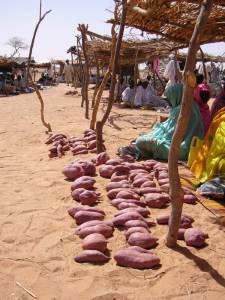Yam is an edible tuber in the Dioscoreaceae family. North Americans sometimes refer to a sweet potato as a yam, but it is not in fact part of the same family. Yams are hugely popular in Africa and are a very versatile vegetable
Planting Yams
Yams are propagated from small sections of other yams. They are best planted in shady positions. They do their best in a tropical, humid climates in temperatures over 20°C with plenty of rain. Soil should be moisture retentive, but like all tubers the yam is prone to rot, so soil that gets waterlogged easily is not appropriate.
Yams should be planted a little raised in ridges. Plan them before the rains begin in the tropics. They won’t do well without warmth and rain, so if your area does not have both of the concurrently then you may be out of luck.
Plant the small sections of other yams about 6 inches (15cm) deep. Keep the ridges 4 feet (120cm) apart and plant each yam a foot (30cm) apart within these ridges.

Yams in their native Africa. Photo by Mark Knoble.
Growing Yams
Yam plants grow vertically, so you will need to set up a trellis or netting a good 2 meters high. This is really the only difficult part of growing yams.
Yams are almost entirely hands off to grow. As they require tons of water, gardeners will need to rely on rain unless the want to spend an hour each day watering yams alone. The most important time for rain is 3 to 5 months after planting.
Harvesting Yams
Yams take 8-12 months before they are ready for harvest, depending on the variety. The ‘time to harvest’ sign is when the leaves and stems start to shrink.
They store particularly well in a dry place for a few months. Much like when they were in the ground, they do not like cold weather, but if you’re in the tropics anyway there’s little chance of yams sustaining any damage due to chills.
Threats to Yams
Yams are generally free of problems.
